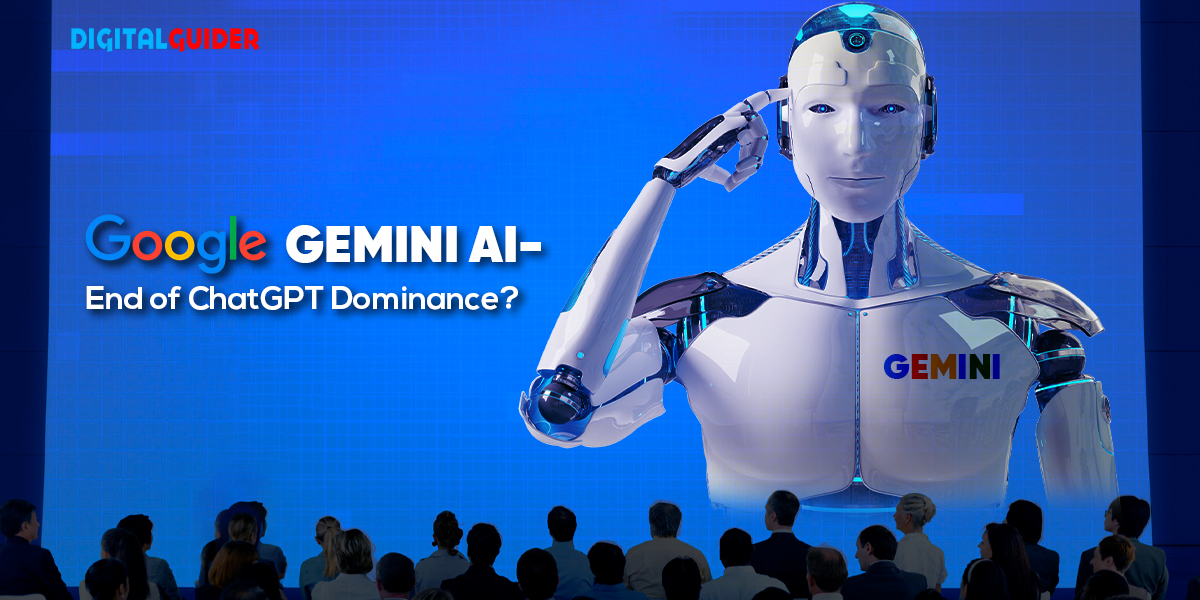As the technology landscape evolves, Google Gemini AI stands at the forefront of this change. Alphabet CEO Sundar Pichai first announced Gemini AI at the Google I/O keynote developer conference in May 2023, the large language model developed by the Google DeepMind division (Brain Team + DeepMind).
The “Google Gemini AI release date” speculation intensifies as December 2023 approaches. Initial reports suggest that Google might make its much-anticipated AI available on its Google Cloud Vertex AI platform, ushering in a new era of advanced artificial intelligence. The tech community is eagerly awaiting the Google Gemini AI release date, as several companies have already experienced a preview of what is to come. Let’s get to know the detailed updates on what is Google Gemini AI, how it works, what best uses & features are available, who can access this, how is it better than ChatGPT & more.
What is Google Gemini AI?
Gemini, created by Google’s world-renowned DeepMind team under the direction of Chief Executive Officer Demis Hassabis, is set to revolutionize the way we think about AI. Google Gemini AI is a collection of large-language models that can handle various data tasks, and read and understand whole pages, including signature blocks, document stamps, process text, images, audio, video, 3D models, and graphs simultaneously.
Drawing inspiration from the victorious AlphaGo, Gemini uses the power of problem-solving techniques & advanced language processing to surpass existing AI models, including OpenAI’s ChatGPT. This could mean Google Gemini is more powerful & versatile than GPT-4 or ChatGPT. Google had said that DeepMind Gemini AI was created “to be multimodal, highly efficient at tool and API integrations, and to enable future innovations such as memory and planning.”
Google CEO Sundar Pichai emphasized that Gemini combines DeepMind’s AlphaGo strengths with extensive language modeling capabilities. Gemini will let users process & generate text, images, code, audio content, and other data types with a multimodal design through a single user interface (UI), enabling more natural conversational abilities.
Aim of Google Gemini AI project
The DeepMind Gemini project will tackle complex problems through algorithms’ deep learning process and reinforcement learning techniques. Most importantly, different fields of work will widely consider its use for future innovations. It could help scientific researchers in their various studies to provide solutions to their problems in climate change, healthcare departments, aviation, food, agriculture, etc. Keep reading the details on what is Google Gemini AI, how it works, best features & more.
Best Uses Of Google Gemini AI

Image Source: Google I/O 2023
Sundar Pichai, CEO of Google Alphabet, mentioned at Google I/O 2023 that they are making generative AI more helpful for everyone. PaLM 2 and Gemini are one of them. DeepMind Gemini is designed to be multimodal, meaning that it can process and understand different types of data, including text, images, and code. This makes it well-suited for various tasks, such as
- Generating text, translating languages, and writing different kinds of creative content.
- Gemini can generate and process data like graphs and maps.
- It is trained on a massive text and code dataset, giving it a vast knowledge base.
- Creating new products and services.
- Analyzing data and identifying patterns.
- Answering questions in an informative way, even if they are open-ended, challenging, or strange.
The multimodal processing component in Gemini is still in development, but it can potentially revolutionize our interactions with computers. It may be used to produce more realistic and engaging virtual assistants and new educational tools and even improve our comprehension of the world around us. Keep reading the details on what is Google Gemini AI, how it works, best features & more.
How Does Gemini Work?
Gemini uses machine learning based on prior recordings and looks ahead at future recordings to verify and ultimately self-approve title plant entries. Borrowing from the same technology that powers self-driving cars and facial recognition, DeepMind Gemini reads:
- Document stamps
- Document Types
- Legal Descriptions
- Parties & more.
Gemini uses Data Mining tools to mine previously keyed data, learning and verifying as it reads. Gemini knows when it needs help and builds queues for human helpers to lend a hand.
Gemini uses a new architecture that merges a multimodal encoder and decoder. The encoder’s job is to convert different data types into a common language that the decoder can understand. Then, the decoder takes over, generating outputs in other modalities based on the encoded inputs and the task at hand.

The process can be broken down into the following steps:
- Input: The user provides the inputs in various formats – text, video, images, audio, 3D models, graphs, etc.
- Encoder: The encoder takes the inputs & converts them into a common language that the decoder can understand. This is done by transforming the different data types into a unified representation.
- Model: The encoded data is then inputted into the model, which is task-independent. This means that the model does not need to be aware of the details of its task; it can simply process the data according to the task’s requirements.
- Decoder: The decoder extracts and outputs the raw data from the model. The outputs may be presented in various formats depending on the user’s preference.
- Output: The generated outcomes are then returned to the user.
Google Gemini Features
Zoubin Ghahramani, the Vice President of Google DeepMind, said that Gemini will be available in the exact four sizes as PaLM 2: Gecko, Otter, Bison, and Unicorn.

Image Source: Google I/O 2023
1- Gecko:
Gecko is the smallest version of PaLM 2, with 1.2 billion parameters. It is designed to be lightweight and more efficient, making it suitable for mobile devices and other resource-constrained environments.
2- Otter:
Otter is a mid-sized version of PaLM 2/Gemini, with 137 billion parameters, designed to be more robust than Gecko. It balances size and performance well, making it suitable for a wide range of unimodal tasks.
3- Bison:
Bison is designed to be a larger, more versatile version of Gemini than Otter, with 540 billion parameters. It is likely suitable for a limited number of multimodal tasks and is expected to compete with Chat GPT-4 for market share. This model is optimized for high-level cognitive tasks, including natural language processing (NLP), text generation, and question-and-response (Q&A). Bison is an excellent option for a high-performance model for complex cognitive tasks.
4- Unicorn:
Unicorn is designed to be the giant version, the most robust and versatile Gemini size, with 1.5 trillion parameters. It is expected to be suitable for a wide range of multimodal tasks and go far beyond the capabilities of ChatGPT or any of its competitors. It is still under development but is expected to be the most powerful LLM ever created.
How do I access Gemini AI?
As you can see in the image below, Google mentions that DeepMind Gemini is still in the training & development process.

The search and advertising giant plans to make Gemini available to companies through its Google Cloud Vertex AI service. The fusion promises to offer businesses unparalleled AI-driven solutions. Google has provided access to the early version of its artificial intelligence (AI) model – Gemini – to compete with OpenAI’s GPT-4, a report by The Information revealed. Keep reading the details on what is Google Gemini AI, how it works, best features & more.
Google Gemini vs. ChatGPT
Here is a comparison of Google Gemini and ChatGPT in five key areas:
| Key Areas | Google Gemini | ChatGPT |
| Size | 175 billion parameters | Smaller than Google Gemini |
| Multimodality | Multimodal processes text, images, and other data types | Text-based, cannot process images |
| Memory and Planning | Better memory and planning capabilities for context | Limited memory and planning capabilities |
| Efficiency | More efficient, faster text generation, lower computational resource requirements | Less efficient, slower text generation, higher computational resource requirements |
| Future Potential | Under development, the potential for future improvements | Developed, less room for future enhancements |
Also Read: Google Bard vs. ChatGPT: Everything You Need To Know
Conclusion: The Future of AI with Google Gemini
As we advance in today’s modern technological AI era, we now see more AI-based programs, chatbots, or tools being released. Each of these AI models claims to be better than its rival. The same is the case with Google’s upcoming Deepmind Gemini. Gemini is not just a new AI model; it’s a glimpse into the future of AI. With its multimodal capabilities and creative prowess, Gemini is set to redefine what AI can do and how we interact. Whether or not it would be more powerful than OpenAI’s ChatGPT is a debate of later stage.
With its ambitious goals and Google’s expertise, Gemini AI promises to set new benchmarks for AI capabilities, transcending the limits of traditional models. The AI community eagerly awaits further updates on Gemini’s progress, anticipating the dawn of a new era in artificial intelligence. As the project gains momentum, it will continue to shape the future of AI, driving innovation and opening new possibilities across sectors. The true impact of Gemini and its potential to surpass existing AI models will become increasingly evident as it progresses.







